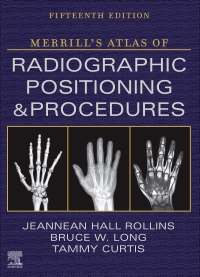
Merrill's Atlas of Radiographic Positioning and Procedures - 3-Volume Set - Elsevier eBook on VitalSource, 15th Edition
Elsevier eBook on VitalSource

Now $254.69
**Textbook and Academic Authors Association (TAA) McGuffey Longevity Award Winner, 2024**
**Selected for Doody’s Core Titles® 2024 with "Essential Purchase" designation in Radiologic Technology**
Perfect your positioning skills with the leading radiography text and clinical reference! Merrill's Atlas of Radiographic Positioning & Procedures, 15th Edition helps you learn to position patients properly, set exposures, and produce the clear radiographs needed to make accurate diagnoses. Guidelines to both common and uncommon projections prepare you for every kind of patient encounter. Anatomy and positioning information is organized by bone group or organ system, and coverage of special imaging modalities includes CT, MRI, sonography, radiation therapy, and more. Written by noted educators Jeannean Hall Rollins, Bruce Long, and Tammy Curtis, Merrill's Atlas is not just the gold standard in imaging — it also prepares you for the ARRT exam!
Newer Edition Available
Merrill's Atlas of Radiographic Positioning and Procedures - 3-Volume Set - Elsevier eBook on VitalSource
-
- Comprehensive, full-color coverage of anatomy and positioning makes Merrill's Atlas the most in-depth text and reference available for radiography students and practitioners
- Guidelines to each projection include a photograph of a properly positioned patient and information on patient position, part position, central ray angulation, collimation, KVp values, and evaluation criteria
- Diagnostic-quality radiograph for each projection demonstrates the result the radiographer is trying to achieve
- Coverage of common and unique positioning procedures includes chapters on trauma, surgical radiography, geriatrics/pediatrics, and bone densitometry, to help prepare you for the full scope of situations you will encounter
- Numerous CT and MRI images enhance comprehension of cross-sectional anatomy and help in preparing for the Registry examination
- Frequently requested projections are identified with a special icon to help you focus on what you need to know as an entry-level radiographer
- Image receptor and collimation sizes plus other key information are provided for each relevant projection
- Bulleted lists provide clear instructions on how to correctly position the patient and body part when performing procedures
- Summary tables provide quick access to projection overviews, guides to anatomy, pathology tables for bone groups and body systems, and exposure technique charts
-
- NEW! Updated content reflects the advances and continuing evolution of digital imaging technology
- NEW! Revised positioning techniques reflect the latest American Society of Radiologic Technologists (ASRT) standards, and include photos of current digital imaging for the lower limb, scoliosis, pain management, and the swallowing dysfunction.
- NEW! Added digital radiographs provide greater contrast resolution for improved visualization of pertinent anatomy
-
1. Preliminary Steps in Radiography
2. General Anatomy and Radiographic Positioning Terminology General Anatomy and Radiographic Positioning Terminology
3. Thoracic Viscera: Chest and Upper Airway
4. Abdomen
5. Upper Limb
6. Shoulder Girdle
7. Lower Limb
8. Pelvis and Hip
9. Vertebral Column
10. Bony Thorax
11. Skull, Facial Bones, and Paranasal Sinuses
12. Trauma Radiography
13. Contrast Arthrography
14. Myelography and other Central Nervous System Imaging
15. Digestive System: Salivary Glands, Alimentary Canal and Biliary System
16. Urinary System and Venipuncture
17. Reproductive System
18. Mammography
19. Bone Densitometry
20. Mobile Radiography
21. Surgical Radiography
22. Pediatrics Imaging
23. Geriatric Radiography
24. Sectional Anatomy for Radiographers
25. Computed Tomography
26. Magnetic Resonance Imaging
27. Vascular, Cardiac, and Interventional Radiography
28. Diagnostic Medical Sonography
29. Nuclear Medicine and Molecular Imaging
30. Radiation Oncology






 as described in our
as described in our 